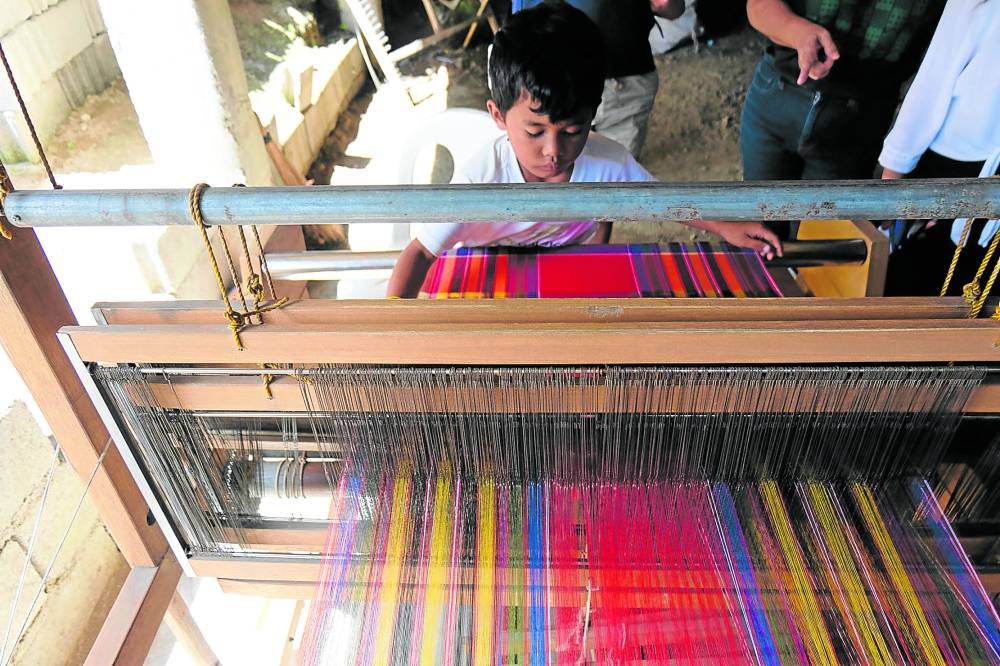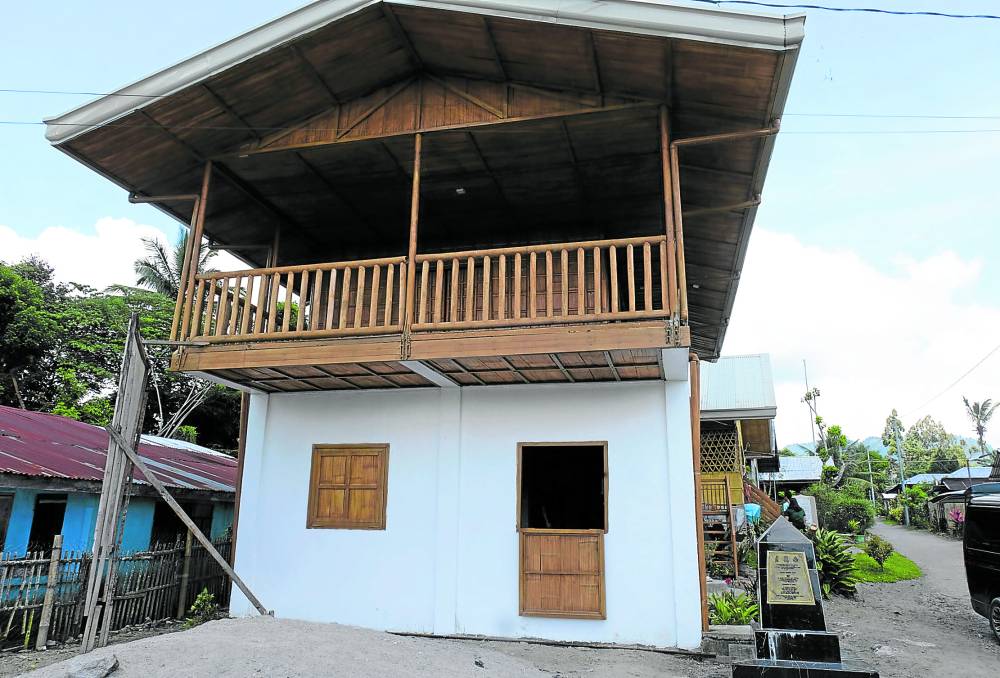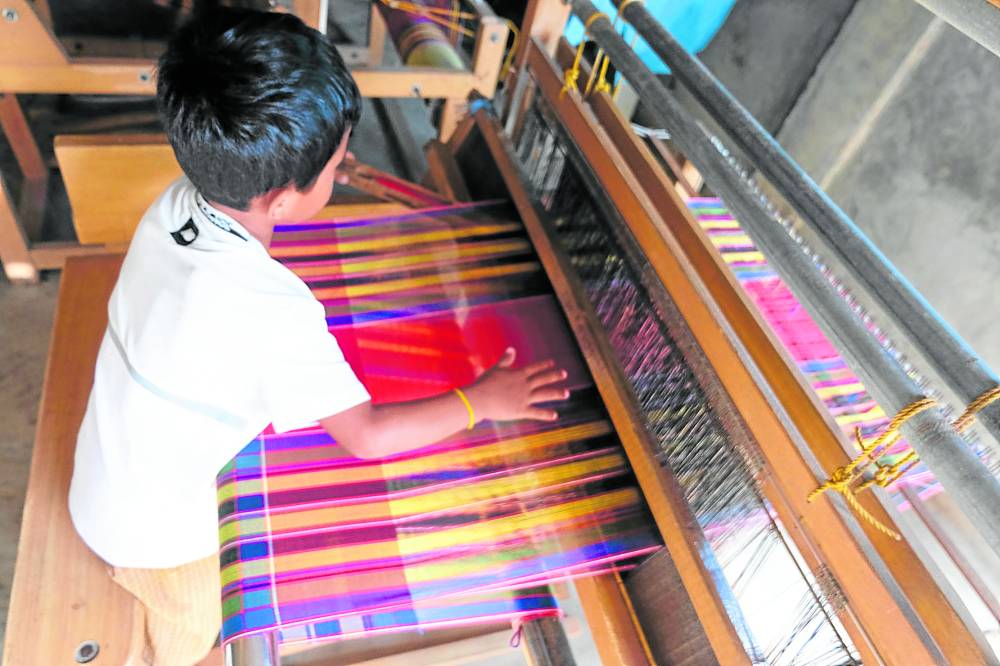Blaan boys help keep weaving tradition alive

NEXT IN LINE A mannequin (below) displays a traditional dress made out of “gintlo,” a Blaan term for malong. The indigenous peoples group’s boys (top, bottom) have recently taken up the cudgels to preserve the intricate art of weaving the garment that is once only an activity reserved for women. Photo by Bong Sarmiento
POLOMOLOK, SOUTH COTABATO, Philippines — In a remote community nestled in the rolling foothills of Mt. Matutum, South Cotabato’s landmark peak, boys are taking up the cudgels to keep their traditional weaving practices alive.
Prince Xian Gulili, 8, for one, is doing the “girly” thing of weaving, an art mastered to an exceptional degree by his great grandmother, Yabing Masalon Dulo, known to her community at Sitio Amgu-o in Barangay Landan here as Fu Yabing.
In Blaan culture, weaving is an activity mainly reserved for women and rarely a domain of boys.
READ: Blaan master weaver Yabing Masalon Dulo passes away at 106
So, it was a pleasant surprise to see Gulili, fondly called Shan-shan, one day under a stilt house, clack up a loom to finish a “malong” using synthetic silk-like fibers. Popular among indigenous groups in Mindanao, malong is a traditional versatile tubular garment that can be used as skirt, blanket or bedding, among others.
Article continues after this advertisement
LEGACY A two-story house at Barangay Landan in Polomolok, South Cotabato, the nerve center of preserving the legacy of Fu Yabing, the master of Blaan “ikat” weaving, who is immortalized in a bust (top) marking her grave just across the facility.
“I am not only learning the weaving process, I am also earning from it for my allowance in school,” Gulili said, speaking in Ilonggo.
Article continues after this advertisementGulili is a great grandchild of Fu Yabing whose mastery of the “mabal tabih,” the woven abaca cloth of the Blaan indigenous tribe, earned her the Gawad sa Manlilikha ng Bayan (Gamaba), or national living treasures award, from the National Commission on Culture and the Arts (NCCA) in 2017.
Fu Yabing, a revered Blaan princess who died in her sleep on Jan. 26, 2021, at the age of 106, honed her craft starting at 12.
With her unwavering dedication, she became a master of “mabal tabih” and the art of “ikat” or reserve dyeing. “Mabal” is a Blaan term for the weaving process using abaca fibers while “tabih” refers to the finished hand woven cloth and also the Blaan traditional tubular skirt.
Meticulous process
Blaan abaca-ikat weaving is one of the most challenging and most beautiful works found among the indigenous peoples of Mindanao. Their tradition is related to that of their immediate neighbors in Southwestern Mindanao, the Bagobo and the Tboli, but is also culturally distinct from them, according to the NCCA.
The production of “mabal tabih” is a meticulous process that takes three to four months to finish, hence it does not come cheap. A small tabih (4 meters by 12 inches) fetches P6,000, and the bigger one (4 meters by 30 inches) at P15,000. The intricate designs usually feature images of lizards and crocodiles. On the other hand, malong woven in their community costs from P1,200 to P2,500.
With the rigor involved in weaving, only a few have become interested, which is why the female community members trained by the late Fu Yabing are now also training boys to become weavers like them, said Arthur Gulili Sr., Fu Yabing’s grandson.
He has been at the forefront of initiatives to keep Fu Yabing’s legacy since she passed away almost four years ago.
Training the young
Across Soccsksargen (South Cotabato, Cotabato, Sultan Kudarat, Sarangani, General Santos) region, at least 150 people have been trained on ikat weaving since Fu Yabing died in a bid to keep her tradition alive, but none proceeded to take up the trade, Arthur Sr. noted.
With the likes of the young Gulili learning and mastering the art of weaving, Fu Yabing’s legacy may well live on for decades—and with a pleasant twist as boys like him are now doing the craft once the domain of girls in their community.
When not in school or playing, Gulili can be found in the weaving center just across their house, sitting in a loom to weave a malong. His younger brother, Arthur Jr., is also learning the craft, according to their father.
“I have to do this to keep the legacy of my grandmother alive. We trained boys, not just girls in our community, to become weavers,” Arthur Sr. told the Inquirer.
The community’s efforts to sustain ikat weaving has been challenged by lack of financial resources, with Arthur Sr. lamenting that the law, Republic Act No. 7355 or the Manlilikha ng Bayan Act, “does not provide for the sustainability” of an awardee’s legacy.
All the perks enjoyed by a Gamaba awardee ends after one passes away, he noted, adding that if continued, the monthly stipend could be used to sustain his or her works through constant training of the younger generations.
A Gamaba awardee enjoys the same privileges as a National Artist: a gold-plated medal from the Bangko Sentral ng Pilipinas, a one-time cash award of P200,000, a lifetime monthly stipend of P50,000, and medical and hospitalization benefits of up to P750,000 a year, among others.
“If (only) the government could amend the law so those left behind would inherit the financial privileges as funds to sustain an awardee’s works,” Arthur Sr. said.
Nevertheless, Fu Yabing’s Blaan community has found hope in young boys like Gulili who showed interest in mastering the art of weaving.
Gulili, Arthur Sr.’s second of three children, gets at least P100 for weaving a few hours a week. His school is just 500 meters away from their house, a walkable distance. He says he buys snacks or school supplies from his small income.
Arthur Sr. said their community would continue to teach boys to weave to keep the legacy of Fu Yabing alive for generations to come.


